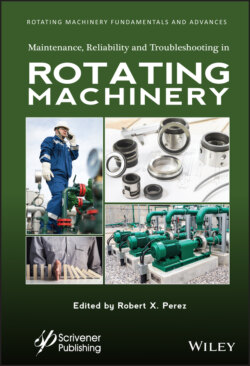Читать книгу Maintenance, Reliability and Troubleshooting in Rotating Machinery - Группа авторов - Страница 38
Cumulative Failure Trends
ОглавлениеManagement is usually interested in knowing if their pump reliability is getting better or worse. A simple means of visualizing historical failure data is by contructing, then analyzing, a special trend called a reliability growth plot, which is a plot of cumulative failures versus time (see Figure 2.5). This type of graph is constructed by first creating a table of cumulative (total) failures in a population for consecuative time intervals, then plotting cumulative failures over the time period of interest. For example, let us say that in the first month 20 failures occur in a population, in the second month 25 failures occur, and in the third month 30 failures occur. This would mean the first three points in your reliability growth plot would be: Month 1, 20 failures; Month 2, 20+25=45 failures; Month 3, 20 + 25 + 30 = 75 failures, or (1,20), (2,45), and (3,75).
Reliability growth plots allow you to easily see tendencies in the failure data. Figure 2.5 shows three idealized reliability growth plots:
Figure 2.5 Reliability growth plot of pump failures in an operating area.
1 A trend where the slope of the cumulative failures is essentially straight, indicating a constant rate of failure (shown as “Constant” in Figure 2.5).
2 A trend where the slope of the cumulative failures versus time sharply increases in July of 2016, indicating a decreasing failure rate (shown as “Decreasing” in Figure 2.5).
3 A trend where the slope of the cumulative failures versus time decreases in July 2016, indicating an increasing failure rate (shown as “Improving” in Figure 2.5).
When readers study a reliability growth plot, they are able to discern if pump reliability is constant, deteriorating or improving. Other insights that a reliability growth plot provide are when a change in reliability occurred, and if the change in reliability was sudden or gradual. In this case, seen in Figure 2.5, we note the deteriorating case indicating that something changed after July 2016. We should look for changes in operating procedures, repair methods, processing rates, etc., to explain changes in pump reliability. Persistent changes in pump reliability may represent some sort of major change affecting your pump or pumps, while a data blip could simply be measurement error, or some sporadic factor, such as a plant upset.
The next reliability plot we will cover is the mean time between repairs (MTBF) trend plot (Figure 2.6). MTBF is a simple calculation that provides insight into the mechanical reliability of a single or a group of pumps, which is calculated as follow:
Let’s go through an example of how we can evaluate the change in the MTBF of a large population. Let’s assume you have 1,000 pumps in your facility and that in year #1 you repaired 375 pumps and that in year #2 you repaired 300 pumps.
The average MTBF for year #1 is:
Figure 2.6 A hypothetical trend plot of the plantwide mean time between repairs (MTBF).
The average MTBF for year #2 is:
These data show a 25% improvement in the mean time between pump failures from year #1 to year #2.
Instead of continuously calculating the MTBF and reporting a single number to management, we can plot the moving average trend of a population’s MTBF. This type of plot can be used to keep an eye on a single or large population of process machines. A moving average MTBF plot is constructed by calculating then plotting the calculated MTBF from the data from the previous month, quarter, or year. Plotting the MTBF data in this way tends to smooth out the data and simplifies the analysis. By inspection, we can see that the MTBF of a hypothetical pump population in Figure 2.6 is gradually deteriorating. Your next step might be to examine the individual trends of each of your process units to see if they are all deteriorating or if there are some poorly performing unit populations forcing the overall plantwide reliability down.
MTBF: Readers should keep in mind that the MTBF metric is a global metric and only provides limited information about a given machine population. As you drill down to the equipment levels, more advanced analyses, such as Weibull analyses, may be warranted to examine the failure data and to better understand the nature of the failures.
I have briefly covered a few machinery reliability analysis tools that I have personally used to analyze spared machines during my career. The data used to create these metrics are readily available and can easily be organized and then analyzed using Excel or similar software applications. The concise visual results can then be quickly interpreted by your colleagues and management.
